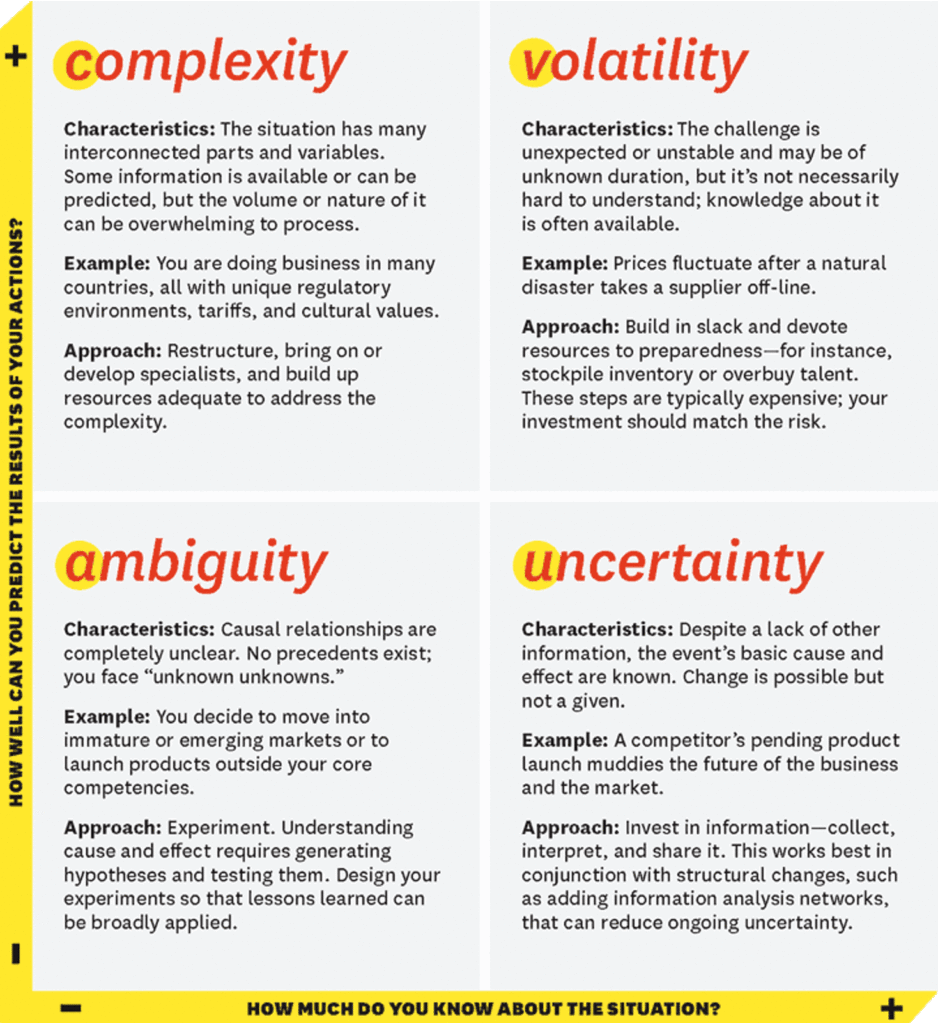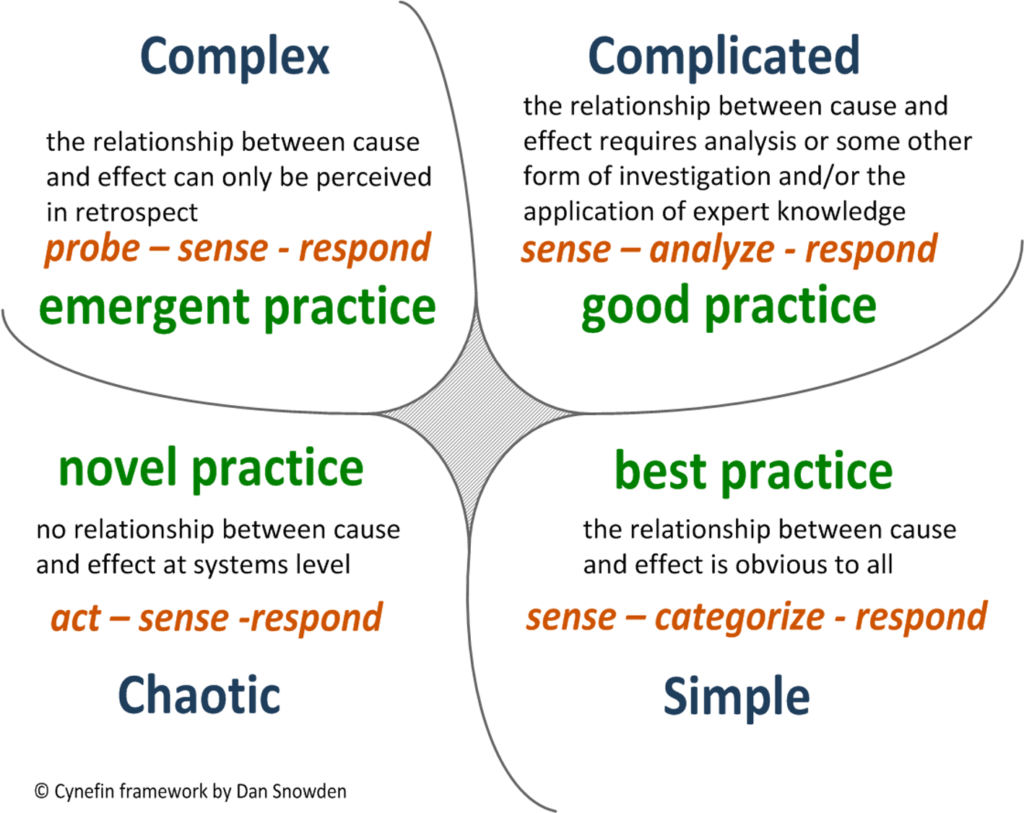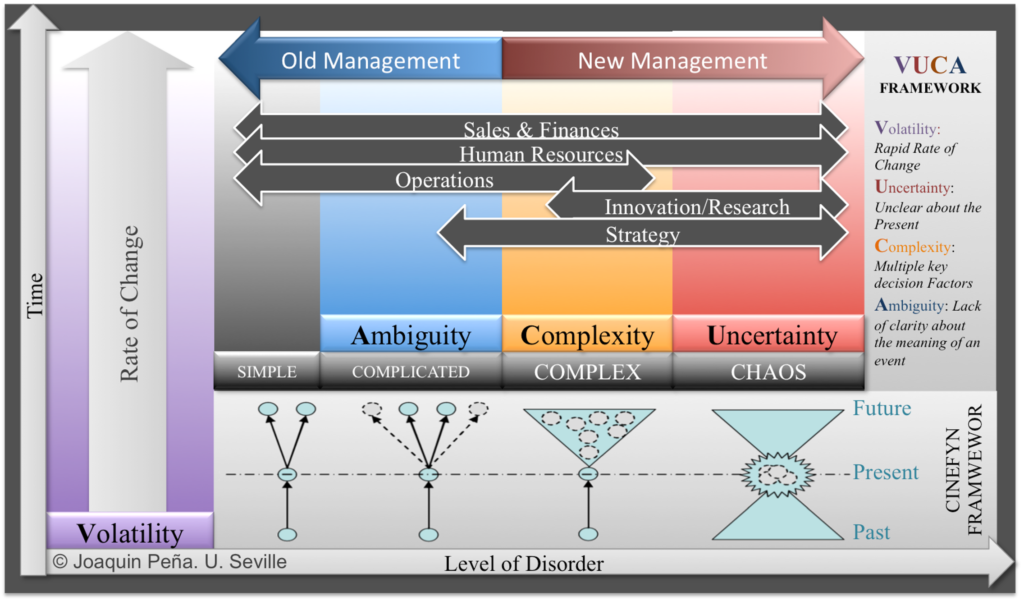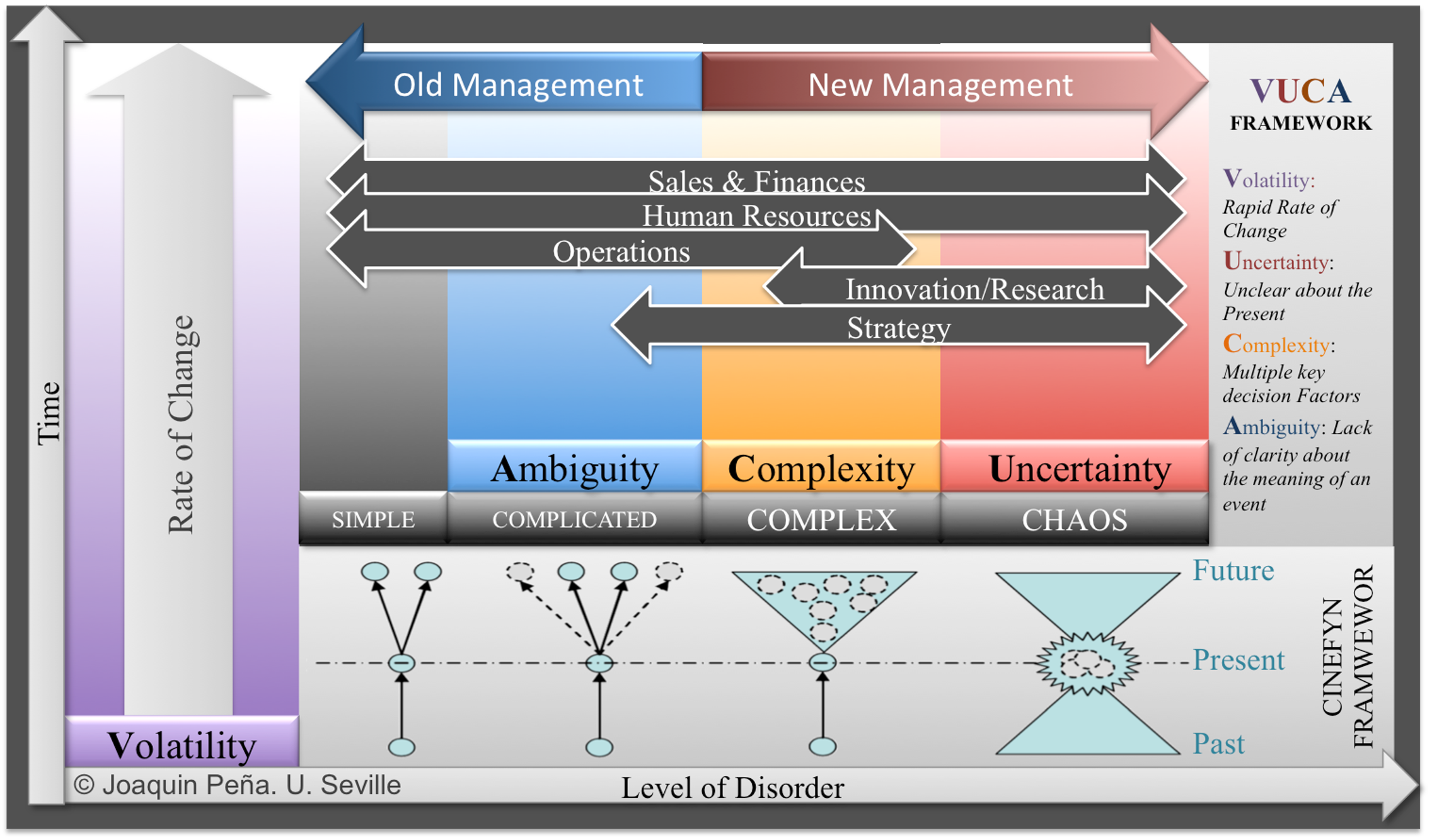The 4 Principles to Manage The Unmanageable: The New Management In The VUCA World
Joaquin Peña. University of Seville.
Do you attend meetings constantly, do teleconferences all the day, and have over 100 emails daily? The average amount of time dedicated globally to interruptions is the 65% of the working hours. Yes, all of us employ most of our time to tackling unforeseen tasks. This means that:
You have only about 2/3 hours (35%) for working on your tasks.
We call such time “interruptions”, but the reality is that it is the time we use for synchronizing the people of the organization to run jointly in the same direction. That is a VUCA world. It is a rapid changing world where we have to speak to each other constantly to maintain us on route.
In this article, we analyze how is the business world today and depict the 4 main principles to manage in a rapid changing environment. The results are based on the insights found on the studies we are conducting at the University of Seville (if you want to participate in the study and have your organization evaluated and an action plan, contact us at joaquinp at us.es).
Back in 1991, while a big conflict was happening at Kuwait, the Gulf War, in the other part of the world researchers and instructors of the U.S. Army War College were facing the management and strategy designing of these «modern» scenarios of war. They came to the conclusion that the main problem was the difficulty to design stable strategies and plans in a highly changing environment. As a result, they defined the term VUCA (Volatile, Uncertain, Complex and Ambiguous) for describing rapid changing unstable scenarios.

Figure 1 VUCA definition by HBR. What VUCA Really Means for You (https://hbr.org/2014/01/what-vuca-really-means-for-you)
At the same time Gulf War was happening, the business management world was “stable” and started to be worried about their people. In that years, we started to see the value of learning as a result of the concept «the learning organization” developed by Peter Senge, and developed the Ethics of Business after the conclusions drawn from The Malden Mills Industries fire (https://en.wikipedia.org/wiki/Malden_Mills) in 1995. Five years later, in 2000, the Business Process Management (BPM) field started to be popular. Its main focus was introducing order and efficiency in the knowledge work.
Today, Only a few years later from the operationalization of knowledge work, BPM is almost a dying adolescent. The globalization of the markets and the tremendous speed of communication thanks to the communication technologies advances have depicted a business world full of possibilities. A world where a process defined today is obsolete tomorrow. A world, that can be the perfect place for Tesla Motors redefining all the energy market, or the worst nightmare for businesses that keep following the what common sense of yesterday dictates.
Almost 2 decades after the Gulf War, The VUCA term, designed to manage war situations, has gained popularity to define the current business world. We are living times with more options than ever before, but also of tremendous speed and difficulties to understand clearly even what happened yesterday. Times where managing a company is like driving a car in the night with headlights off.
The world is different and the rules are different.
We have to learn the new rules and principles of driving in this new highway.
Understand The New Complex Business Environment
10 years after the definition of the VUCA term, the George W. Bush Administration had to manage a country with complex problems such as the Setember-11 attacks and the wars of Irak and Afghanistan. The world kept evolving towards VUCA. By that time, Dave Snowden had developed the Cynefin Framework (see Figure 2), another alternative to VUCA for managing highly complex environments, and the George W. Bush team decided to use its principles to tackle the policies needed for such a difficult situation.

Figure 2. The Cynefin Framework
The Cynefin framework was built to manage situations where analyzing and knowing the knowledge available were a complex tasks. If we compare both approaches to manage the complexity of the current world, VUCA and CYNEFIN, as shown in the Figure 3 (developed by our team at the University of Seville), we can see that there is a high correlation.
As you can see in the Figure, in every organization we can find 4 levels of complexity, from simple to chaotic. And the Volatility, i.e. the rate of change, affects making the problem worst when the speed of change is fast.
There is an important frontier between complicated and complex, the frontier that separates the ordered world from the disordered one, the frontier between the old management and the new:
- Old Management: In this space, the past can be analyzed; the future is more or less known (Ambiguous scenarios with low or moderate Volatility). In this arena, we can keep using the yesterday management techniques.
- New Management: In the space of complex and chaotic situations, even with low volatility, the future cannot be predicted clearly. Even the past can be unclear. In those situations, the standard management techniques do not work (e.g. BPM).

Figure 3. New and Old Management Styles. VUCA vs. Cynefin.
The challenge that most organizations have to tackle is determining which parts of their business and organization are just simple/complicated, and which parts have already entered the complex or chaotic domains, which parts are Complex and Uncertain. Managing in each arena is completely different.
Good measures could be the capability of the organization to know the past and predict the future, and the rate of communications (ei. Emails, interruptions, meetings, etc.):
If you have not clear information about the past and you cannot estimate the future with enough accuracy, and individuals in your company communicate at a high speed,
you have to apply the new management tools.
Manage the VUCA world
Managing in the more difficult part of the spectrum requires the application of four principles:
Be Focused
Tesla Motors focuses is changing the way the world uses energy. This is inspiring; this makes every employee passionate about his or her work on defining the future. This principle consists on analyzing the options but without planning in the long term, just having an inspiring vision of the future. In an environment that cannot be predicted it is key to have a clear purpose that help us to see if we are on track. Today nothing is done in isolation. In an uncertain environment, passion and inspiration is the key ingredient that makes people to work together for conquering a better future.
Analyze the options and define an inspiring vision of the future in stead of planning.
Be Agile
In 1911, a bunch of crazy men started to walk towards an inspiring mission, reaching the South Pole. In such an uncertain situation, the only thing they could do was just going forward another day. Journey by journey a new goal were set. Living the moment without knowing which obstacles the will find behind the horizon. On October 24th, Scott and 4 other men left the group to make the final journey. When they walked enough to see the pole, the January 17th, and the visibility allows it, they saw the black flags Amundsen and his team placed about 5 weeks earlier. In current business world, when moving in the hardest part of the complexity scale, we must act in the same way. Plan on the short term, analyze where we are, and plan another journey with the gained insights. This means that setting goals for a whole year and all its quarters is not a good idea when dealing with VUCA environments since those plans take into account only the information available at beginning of the journey. It is better just planning a quarter, or even a shorter period if extreme complexity. Then, with the information gained after the execution of each iteration, we can plan the next period with greater accuracy.
Plan in the short term, and use the information gained to define the next iteration
Learn And Know Your Environment
In 1881, Nikola Tesla was walking when He had a Eureka moment. He used his walking steak to draw on the ground a diagram of the idea that has just appeared in his mind that will change the world, the alternate current. In a chaotic world, we need all the power of our brains, not just the CEO brain, but the power of all the brains in the organization (collective intelligence). Intuition is the most powerful way of thinking. Is the intelligence that makes possible the Eureka moments. Is the tool that N. Tesla used in 1881 to made possible today that the company with the same name change the world again. But for training and improving our intuition, we need to learn constantly and observe the environment without any concrete goal, just for adding data to our intuition to improve it.
To success in a complex environment we have to feed our intuition with training and learning,
and complement it with the previous steps, focus and an agile way of doing
to fuel our brains with experience and an inspiring vision to keep going.
Put All Brains At Maximum Speed
Recently, we have seen how Sweden increases productivity while cutting to a 6 hours work day. Current work and life is very demanding for our brains. We need fresh minds to tackle work and personal affairs. The term “decision fatigue”, highly studied in the last decades, shows us the reason because working 6 hours is better. Our brain is fatigued when too much options, when we make decisions and when we solve difficult problems. And that is exactly what we do in highly changing environments. In such situations, our brains consume energy at a higher rate and we end with empty reserves to tackle the whole day. In this situation, time for resting (even during working hours as Google Famous napping rooms show), flexible and shorter working hours to increase the time in charging energy mode (leisure time), having inspiring goals that fuel our motivation in the workplace, etc. are key to maintain all the brains fresh to use intuition, creativity and our problem-solving capabilities at peak performance.
We have to change the configuration of work to maximize mental, emotional and physical energy.
This has implications for almost all the areas of the organization, as we showed in Figure 3:
- Strategy must have two ways of working: planning at the stable domains, and having inspiring visions at the unstable domains.
- Operations must keep following operational managements techniques, such as BPM, at the stable part, but planning very shortly in the unstable domain using new agile methods for managing this kind of environments (e.g. SCRUM for teams or GTD for individuals).
- Innovation department is key for the new environment. The new rules force them to drive their actions with a single principle: make experiments, observe the results, learn, and execute new experiments with the knowledge gained. This is the reason because methodologies such as “Lean Startup” are being used as the process for guiding innovation in hundreds of companies such as GE.
- Human Resources is the other key department in this scenario since they are in charge of the people of the company, in charge of the intelligence needed for understanding complexity and acting with maximum passion and speed. Those managers should work on maintaining the mental, emotional and physical energy of the workforce at maximum levels, at least for knowledge workers of the company. But all the people in the company has valuable information of the environment even more if they are in the battlefield touching the reality with their own hands. The other challenge for HR is enabling the flow of information to facilitate the collective intelligence building the collaborative brain of the organization.
We are living the Third Revolution of the History, the Knowledge Revolution. Be a revolutionary. Take action now, the future happened yesterday. Today it is late for managing the old style. Start now to manage for a VUCA world and conquer the future.
In you want to participate in our research study and know the results of our diagnostics and an action plan for your company, contact us at joaquinp@us.es

